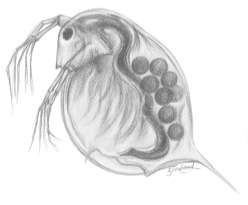
Seanna McTaggart
CIIE Research Fellow
Location: Room 207, Ashworth Laboratory
Telephone:+44 (0) 131 650 6761
Email Seanna McTaggart
C.V.
2005- present Post Doctoral Researcher, University of Edinburgh, UK
2005 Doctorate of Science, University of Guelph, Canada
2000 Master of Science, University of Guelph, Canada
1996 Bachelor of Science, McMaster University, Canada
Research interests
I am generally interested in how genes change through time in response to selection, mutation and genetic recombination. For example, during my PhD, I investigated the selective constraints experienced by a portion of the 18S ribosomal DNA gene with respect to its secondary structure. I was also able exploit the fact that Daphnia can be maintained in the lab as clonal lines in order to track length variant frequency changes in the 18S gene and thus calculate the rate of apomictic recombination for this region of the genome.
Currently, I am working with the newly sequenced Daphnia pulex genome to identify and annotate key immune function genes and gene families. The interaction between host and pathogen provides an ideal system under which to examine the effects of selection on gene evolution. Using a phlyogenetic framework, I am comparing these newly characterized Daphnia immune gene sequences to those of other arthropods in order to identify Daphnia-specific gene family expansion and contractions. These changes are of particular interest as they may provide clues to organism-specific immune responses to their particular suite of pathogens. By comparing patterns of genetic change in these genes between Daphnia species, I hope to identify genes that are putatively undergoing host/pathogen coevolution. For this subset of characterized immune system genes, I will use a population genetics approach to search for evidence of selection.
Publications
McTaggart. S.J., Conlon, C., Colbourne, J.K., Blaxter, M.L. and T. J. Little (2009) The components of the Daphnia pulex immune system as revealed by complete genome sequencing. BMC Genomics 10: 17
Labbe, P., MacTaggart, S.J. and T.J. Little (2009) An ancient immunity gene duplication in Daphnia magna: RNA expression and sequence analysis of two Nitric Oxide Synthase genes. Developmental and Comparative Immunology 33: 1000-1010
Haag, C.R., McTaggart, S.J., Anaïs Didier, A., Little, T.J. and D. Charlesworth (2009) Nucleotide Polymorphism and Within-Gene Recombination in Daphnia magna and Daphnia pulex, Two Cyclical Parthenogens. Genetics 182: 313-323
McTaggart SJ and Crease TJ. Length variation in 18S rRNA expansion segment 43/e4 of Daphnia obtusa: ancient or recurring polymorphism? (2009) The Journal of Molecular Evolution 69(2):142-149.
Brites, D., McTaggart, S., Krystalynne Morris, K., Anderson, J., Thomas, K. Colson, I. Fabbro, T., Little, T.J., Ebert,, D. and L. Du Pasquier (2008) The Dscam homologue of the crustacean Daphnia is diversified by alternative splicing like in insects. Molecular Biology and Evolution 25: 1429-1439
McTaggart, SJ, J Dudycha, TJ Crease (2007) Rates of recombination in rDNA in apomictically propagated Daphnia obtusa mutation accumulation lines. Genetics 311-320
McTaggart SJ and Crease TJ. (2005) Selection on the structural stability of a ribosomal RNA expansion segment in Daphnia obtusa. Molecular Biology and Evolution 22(5):1309-1319.
